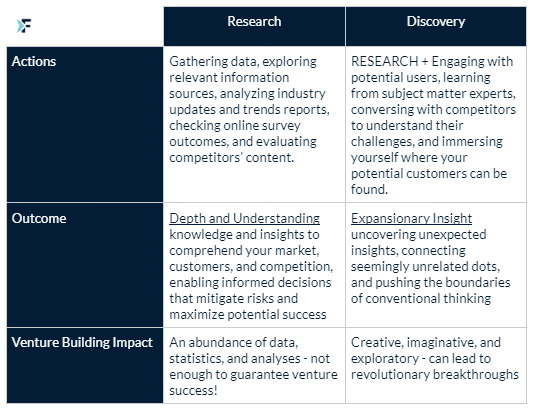As we work with founders, we notice a common trend: founders are often excited to jump into building their ventures and tend to rush through the problem discovery phase. Unfortunately, this haste results in various mistakes, one of which is solely depending on research for their discovery efforts.
We will uncover why all aspects of discovery are crucial for entrepreneurs striving to build successful ventures from the ground up and why research is not enough.
Research Vs Problem Discovery
Research can inform problem discovery by providing context and data. Problem discovery involves a more focused and targeted effort to identify specific pain points within a market.

The Drawbacks to Focusing Solely on Research
1. Ignoring the Human Element
Research tends to focus on quantifiable metrics and objective analysis, often overlooking the subjective and human aspects that play a pivotal role in breakthroughs. Discovery is fueled by intuition, creativity, and empathy—elements that research alone may fail to capture.
2. Data Cannot Predict Serendipity
Data-driven research is inherently retrospective, relying on patterns and trends from the past to predict the future. However, it fails to account for the serendipitous moments and unexpected connections that drive true discovery and innovative leaps.
3. Comfort in the Familiar
People tend to stick to what they know, relying on existing data and established practices. You might be lulled by the comfort found in the familiar and only focused on research that reinforces your prior knowledge and information. However, true innovation often requires stepping into the unknown and embracing uncertainty.
Questions for Reflection:
- How can I achieve synergy between research and discovery?
- How can I do enough experiments to validate my hypotheses?
- How can I step outside my comfort zone to gather new insights and information?
- Am I open to evolving or pivoting the concept based on new information and feedback?
Balancing Research and Discovery
Overcoming these challenges and achieving synergy might seem daunting, yet it holds immense potential. Here are some tips to harness the power of research and discovery to your advantage:
Tip #1: Understand How Research and Discovery Serve Each Other
Recognize that research and discovery are two sides of the same coin. Understand that data-driven insights from research lay the foundation, while discovery fuels imaginative thinking and disruptive innovation.
Tip #2: Embrace Contradictions
Be open to conflicting viewpoints or information. Explore why people might perceive the problem differently from what you found in your research and dive into what underlying factors contribute to those variations.
Tip #3: Prioritize User Motivations
Shift focus towards a user-centric approach to deeply understand the needs, pain points, and aspirations of your potential users. Engage in empathetic conversations, conduct user interviews, and immerse yourself in their experiences to uncover insights that quantitative data alone might miss.
Tip #4: Allocate Time for Experimentation
Set aside time for exploration and experimentation. Create dedicated spaces for brainstorming and idea generation, allowing for the unexpected to emerge.
Tip #5: Iterate on the Process
Treat research and discovery as iterative processes that inform each other. The insights gained from discovery should guide your research questions and areas of investigation. Likewise, research findings can validate or challenge your assumptions, leading to further discovery.
By understanding the symbiotic relationship between research and discovery, entrepreneurs can unlock the true potential of their ventures. Remember, success is not achieved solely through data points and market analysis; it’s the fusion of these insights with the creative discovery that propels innovation forward. So, go forth and let your journey be one of continuous learning, exploration, and breakthroughs.
Written by Eman Ibrahim.
